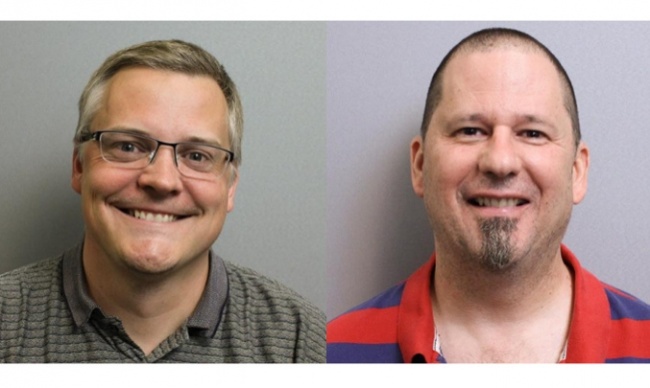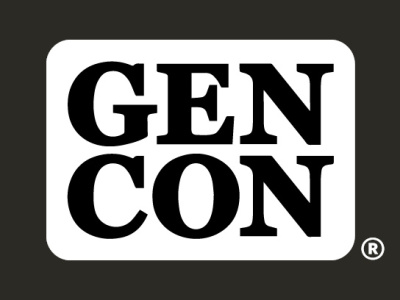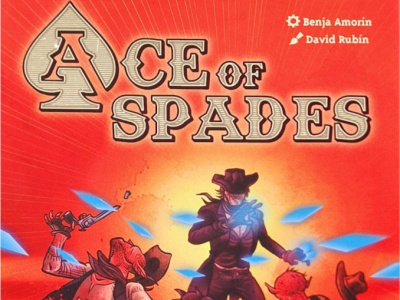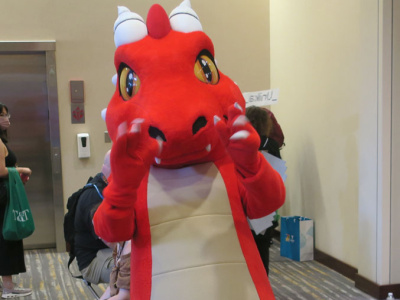Earlier this fall, we visited the Roseville, Minnesota headquarters of game giant Asmodee North America and conducted a series of interviews with Asmodee North America CEO Christian Petersen and Asmodee CMO Steve Horvath. In this interview on the exploding problem of counterfeiting in the games business, we talked about the size of the problem, the impacts, and the dangers.
Here are our interviews with Asmodee execs, and photos from our visit:
ICv2 Interview: Asmodee Execs on the State of the Market, Part 1
ICv2 Interview: Asmodee Execs on the State of the Market, Part 2
ICv2 Interview: Asmodee Execs on New Distribution Policies
ICv2 Interview: Asmodee Execs on the ANA Consolidation, Part 1
ICv2 Interview: Asmodee Execs on the ANA Consolidation, Part 2
Photos from the Fantasy Flight Games and Asmodee North America HQs
ICv2 Interview: Asmodee Execs on Diversity in the Games Business
What’s the relationship between enforcing your new Minimum Advertised Price policy and counterfeits?
Petersen: It's very difficult to enforce MAP when there's so many people selling counterfeits, and receiving product from sources that are illegally procured, but we try hard. In many ways it’s really the Wild West out there where people are discounting stuff 30, 40, 50 percent because they're able to buy it from Chinese counterfeiters, and selling it themselves directly on Fulfill By Amazon or other such vehicles.
It’s a significant problem, perhaps even an existential one. We knew that counterfeiting was becoming a major issue last year, but it really has become a critical industry issues, and has really done a lot of damage over the last ten months.
How do you quantify that problem? What kind of games is it the biggest problem with?
Christian: Quantifying is difficult without data. We are currently working with a number of online outlets to try to understand…
Outlets like Amazon, you mean?
Petersen: I’d rather not get into specific sellers, but for what we consider both good but also not good reasons, some of these respected online outlets are very leery to extend information, even when we have valid known counterfeit product activity on their site.
This is a continuing dialog happening between us and the outlets that are facilitating this illegal trade.
Does any of it make it into the brick-and-mortar trade, or is it all online?
Petersen: We don't know.
Horvath: As far as we can tell, it's only the online trade. But some of it could reach to brick and mortar if they're procuring it from unofficial channels.
Petersen: We're working on a lot of different ways to contain and deter this problem: we’re working in China; we're working in the U.S. with customs; we're also working on trying to identify sellers online, and we will hold those we find accountable.
Every day, we buy a number of different products from major online sites to understand whether some listings are counterfeit or not. Some counterfeits are very obvious, some of it's harder to tell. The products that are most affected, really, are the products that are generally the most popular. Obviously, our top 50 products, but there are probably others that are affected, but we haven’t discovered it yet.
We’ve seen Catan heavily affected by counterfeiting, Ticket to Ride, and 7 Wonders are others.
How do you know there's an effect?
Petersen: Well, number one we can see the overall aggregate effect on our sales in the market. We can see the amount of activity and the amount of anonymous sellers and the irrational pricing online. We have certain products that we know year after year after year will do a certain amount of sales, suddenly crash in proportion to suspect online seller activity, etc.
Horvath: Then you can even see it in things as simple as the reviews. You see on an online site people are talking about what are clearly counterfeit games that they bought, and their disappointment in them where you have all these stellar five star reviews and then you have a one star review talking about quality issues that we know do not exist in the legitimate game.
Petersen: If you, for example, look at 7 Wonders, which has been particularly affected. Go look on BoardGameGeek or go look at their reviews on the most popular online sellers, and you'll see over the last 12 months in particular, that game has suddenly been completely plagued by these issues. We also see counterfeits coming into our customer service department, asking for replacement for poorly crafted, or missing, counterfeit components.
That's, of course, sad for the people that are buying them and are expecting a certain quality experience. But the large majority of the people that buy these games aren't necessarily very discerning gamers, many are just casual gamers and they're not going to realize that they're getting this counterfeit good. They may just feel that this is the level of quality that's to be expected.
Horvath: The dangerous knockoff effect of that is, somebody that is just kind of new to the hobby and buys one of these games online and is really, really disappointed and just makes a value judgment that, “Oh, board games aren't what I heard they were. I'm going to move on to something else.” There's a customer who knows how many games they could have bought over the next 10 years that's just lost to us, and the industry as a whole.
Petersen: There are, I think, four or five extremely difficult problems caused by counterfeiting.
One is the lost sales themselves. A customer is interested in buying one of our products, but buys a counterfeit copy instead, a lost sale. That sucks, that's a problem, it deprives companies, designers and legit retailers of that money.
Number two is the effect that it has on the brands. These counterfeit products are being sold at impossible prices; the legit market simply can’t replicate the price of Chinese-made counterfeit goods selling directly from, for example, an FBA store in the U.S. It just doesn't work, and it devalues…
It makes the legit copies look like a rip-off.
Petersen: Exactly, it's a very significant brand deterioration.
Four, you have the deteriorating perception of the products from bad reviews. You have a great game with a long history of great reviews, but now you’re suddenly getting one star and the two stars reviews piling on because people are getting games where the quality of materials [is poor]: their boards are breaking, their cards are misprinted and mis-cut, there's a garden variety of different quality control problems.
Five, there's a really significant problem with safety. We test all of our products for stuff like lead paint and phthalates. We spend a lot of money on that. We have to spend money on that to make sure that we live up to both U.S. and EU standards in terms of the safety of a product.
But I guarantee you that those are not concerns nor tests that are being done on most counterfeit products. If you're going to walk around and have your kid suck on counterfeit little roads from Catan, you're probably dealing with a hazardous substance exposure.
Horvath: You said yourself that these ridiculously low prices make the normal prices seem inflated. Think about the honest brick-and-mortar retailers that are trying to make a fair living charging MSRP or even within the MAP tolerances that are allowed, it makes them look like they're trying to gouge people as well, on something that's fairly priced.
It's eroding the value proposition of the retail community.
Petersen: And that is a sixth problem, it is hurting legit retailers who cannot compete with Chinese made counterfeit goods…
Where are the original image files for this stuff coming from? Are they leaking out from your manufacturing chain...?
Petersen: Most of these are simply scanned. With today's applicable technology you can get scans and filters, and so on, that are good enough to reproduce a lot of these things adequately. They're not going to be perfect, but unless you're very discerning… On some of these, the counterfeits are really very good. You can tell if you know what you're looking for, but most people, your general consumer buying a game, is not necessarily going to look for this, nor even know to look for anything amiss.
How many consumer dollars in hobby games that were counterfeit were sold last year or in the last six months or any period you want to use?
Petersen: We feel, and this number is speculative (but it's going to be somewhere on that range), that Asmodee North America’s sales are going to be affected somewhere between five and ten million dollars, this year alone. We believe for some games, that more than 70% of all sales in the U.S. market have been counterfeit.
Are you seeing it across categories? Is it mostly cardboard stuff or are they doing plastic miniatures? Are they doing card games, collectible card games?
Petersen: We're seeing more of the plastic miniatures stuff. That's a lot more rare because, of course, the investment the counterfeiters have to make is higher.
What you'll often see is a product being advertised cheaply by a new seller. The consumer will go, “This is really great. I want to buy that at $20 bucks when it's normally $40.” You go ahead and buy that. What ends up happening is that seller has no product at all. They're falsely declaring that they have these products.
However, the bad actor just got a lot of valuable information by you deciding that you're going to buy that for $20.
We saw a lot of this activity, particularly last summer. These scammers go online and figure out, through a lot of market research (maybe they do a thousand different products, who knows) where they get the most activity and cost-to-price, and those are the products they’ll counterfeit.
Of course, the more consumer interest there was in that R&D phase, the more risk they'd be willing to make. Yes, even scammers have to take inventory. Even counterfeiters have to take inventory.
They also will have a lot of information about the price sensitivity of a given product, what's the number of clicks and hits, and even outright sales that they would have gotten had they had that inventory. If they see something that's hot enough, they don't mind, necessarily these days, making an investment in tools [for plastics manufacturing]. So we’re beginning to see some products with plastics in counterfeit product, Ticket to Ride being an example.
Usually, what the counterfeiters will do, is to use an actual plastic miniature from a real game as the “master”. What ends up happening during the tooling process is that the new replica is going to shrink a little bit. What you therefore see, typically, from a counterfeit product is a plastic miniature that's maybe 10 percent smaller, 15 percent smaller than the original. That is something that happens naturally when you're going through the whole tooling and injection process.
Historically there have been problems in the CCG space for a long time, it’s sort of ebbed and flowed, but the board games, the miniature games seem to be a new thing. What's the solution?
Petersen: This is not just something that's limited to our industry. As an example, we have a dog at home. We use something called Frontline, which is something you drip on a dog's neck. It's a medicine that repels ticks or something to that effect. Of course, dogs can get sick from tick bites.
I was surprised to see and learn that, in fact, at one point, many of the people selling Frontline online were selling counterfeits, green goo with no medicinal effect at all. People's dogs were getting hurt. They were thinking they were protected against ticks and they were still getting infected by tick bites.
We just had a solar eclipse here. Apparently there were millions of glasses that were sold counterfeit supposedly with authentic “safe” brands, but they were not. They were not actually protecting you if you were to look up at the sun, so we now have a number of people around the country of people whose eyes were damaged by buying counterfeit goods.
Many times counterfeiting doesn't just deprive people who make an investment into a patent or a copyright or a trademark. It's actually a safety issue, as well. I think there has to be some legislation to resolve this.
It's already illegal, right?
Petersen: It's already illegal but I think it's going to have to be fixed by…
Horvath: ...stronger legislation.
Aren’t the suppliers offshore? How do you get to them?
Petersen: There used to be a guy that could open up his trench coat and show you some counterfeit watches in an alley. Now you are getting that counterfeit merchandise under the guise of what seems very, very legitimate sources, whether it's on Amazon or through another site. Fact is, the guy in the trench-coat has made it into the big-time, but the public has not really caught up this yet.
We’re working in China and other places to get at the suppliers, but they thrive because of the easy road-to-market, so new ones spring up as soon as one is closed.
Should legislation be focusing more on the platforms that are allowing this stuff to be sold, like Amazon or eBay?
Petersen: I don't have a solution for that to share with you right here today but, certainly, we need to have some way to hold people accountable that are selling a product that's either breaking the law, or that is a product that's going to cause a safety issue with a user.
Looking at illegal digital products, the only thing that's worked is focusing on the platforms, like YouTube or whatever. Now you can issue a takedown notice to somebody that's selling a file that they don't own. Can you do the same thing to somebody that's selling one of your games?
Petersen: Yes, you can, but those tools are still very nascent. Frankly, they don't work very well right now. Not only are these “takedown tools” not very good, but as you know, in order object to an activity, you have to have some way to know who are the good guys and who are the bad guys. Illicit use is relatively easy to see on a YouTube digital video, but how can game publishers know whether one online solicitation or another by an anonymous dealer is counterfeit or legit? We have to do test purchases, but by the time that we evaluate the products and find counterfeits, how much damage has already been done? Many times the counterfeit vendor may already have closed up shop and started a new one under a different anonymous name.
One of the ways we know who the good guys are, of course, is through our retailer authorization program. We're able to know these retailers are the good guys. We can say, "All right, these guys need to be authorized on this or that online site. We want the good guys out there selling our games, whether it's online or in physical locations." So, our retail authorization program is one way we can at least tell who the good guys are.
How can retailers help, reporting it?
Petersen: Yes. If a retailer gets any counterfeit goods in their store as a return, I think it's very important that they understand where it's coming from, and they educate the public about the services that the legitimate retailers are offering. If they are solicited by a seller of counterfeit goods, they can contact us directly and we’ll get after that bad actor asap.
It's the very early stages of the public becoming aware of the counterfeiting epidemic, but I think it's affecting the global marketplace in a much more significant way than is perceived right now. I hope that everyone will wake up to this problem soon.

'A Significant Problem, Perhaps Even an Existential One'
Posted by ICv2 on January 9, 2018 @ 6:28 am CT
MORE GAMES
Column by Scott Thorne
August 11, 2025
This week, columnist Scott Thorne notes a new twist in the Diamond Comic Distributors saga and shares his thoughts on the Gen Con releases that will make the biggest impacts.
Due to 'Inappropriate Illustrations'
August 11, 2025
Devir Games is recalling its recently released game Ace of Spades , which it acknowledges included "inappropriate illustrations, texts, and card effects."
MORE NEWS
Thursday July 31, 2025; 'D&D,' 'Riftbound,' and More!
August 8, 2025
The story of Gen Con 2024, as told through ICv2's staff photos, began on the morning of Thursday July 31, 2025 on the convention hall floor.
Dark, Erotic Manga Based on Short Story by Edogawa Rampo
August 8, 2025
Maruo brings his signature “erotic grotesque” style to a dark tale by writer Edogawa Rampo.








